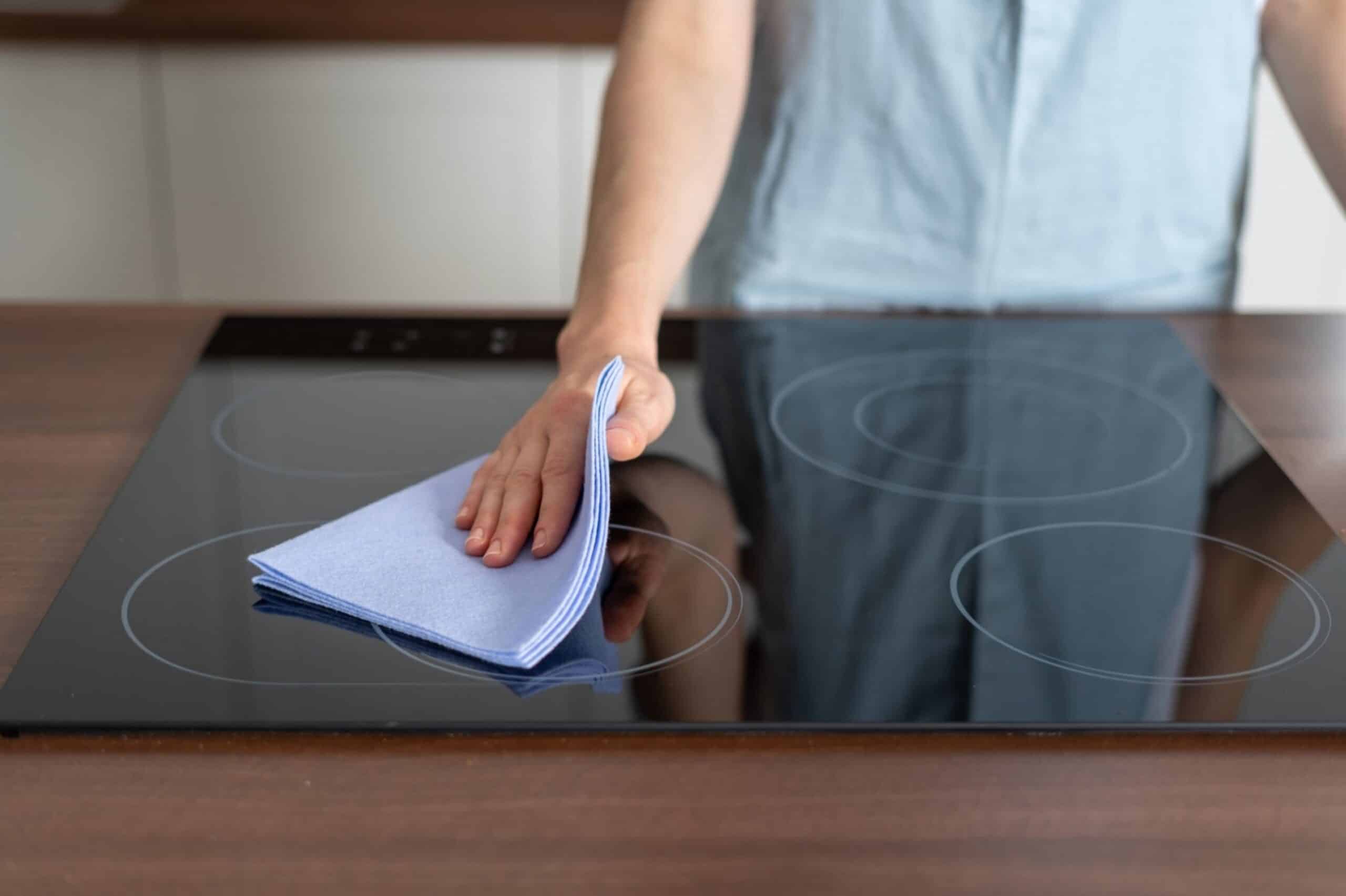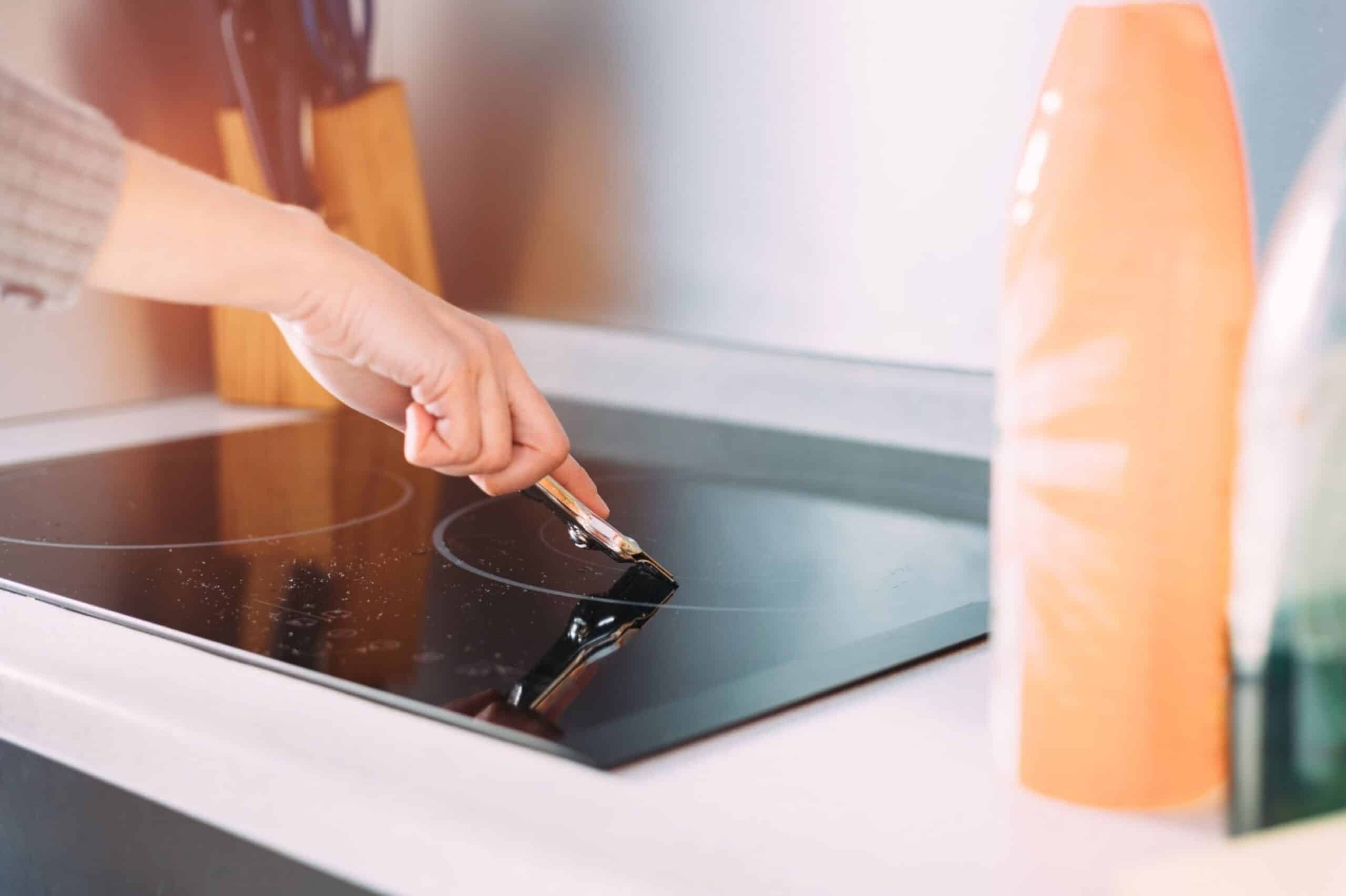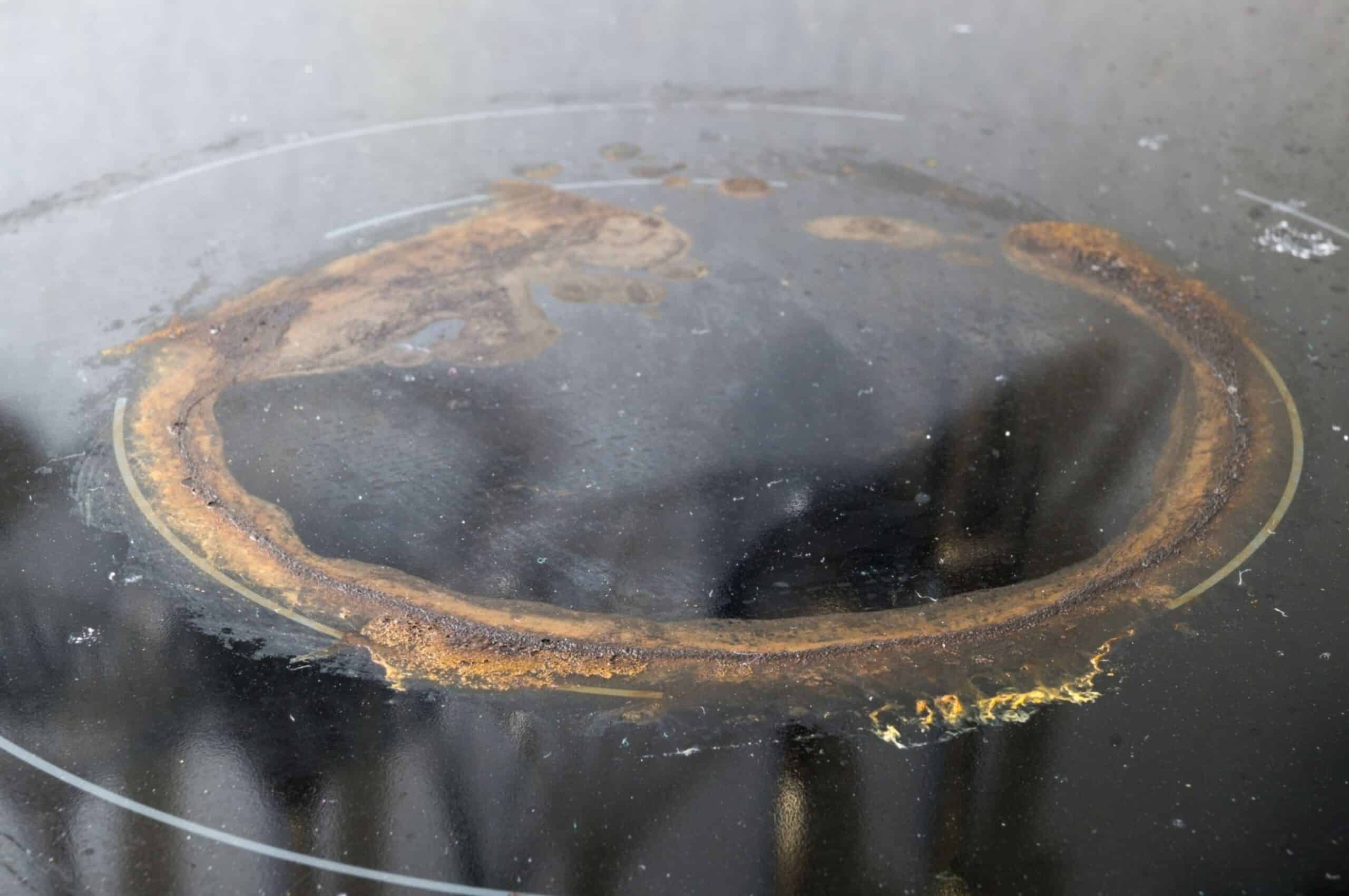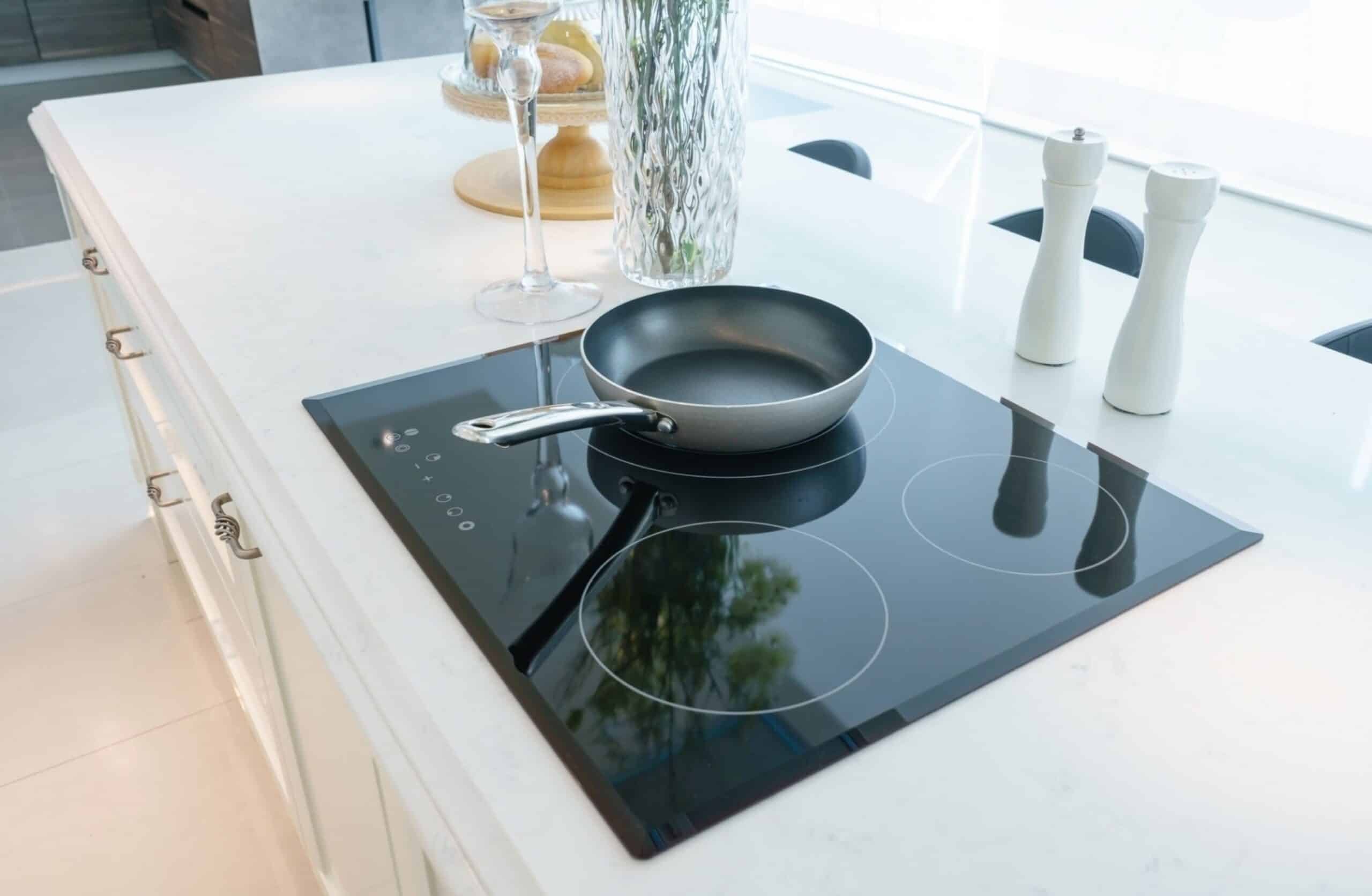Glass-top stoves are beautiful, sleek, and can elevate the appearance of any kitchen. However they notoriously catch spills and other cooking stains very easily, so what’s the best way to keep them clean? We’ve got you covered with this helpful cleaning guide along with some tips and tricks for keeping your glass cooktop looking shiny and clean and ready for every meal.
Everyday Upkeep
The best way to keep your glass-top stove clean is by wiping the surface of the stove once its cooled after every use. For basic cleaning you can stick with a microfiber cloth or a soft sponge so that you don’t scratch the surface. You can either use warm water and mild dish soap or a bit of white vinegar to clean the surface and leave it looking shiny and free of any streaks.
Remember to clear the surface of any pots and pans and to make sure that the cooktop is turned off and cool to the touch before you clean it.
Weekly Deep Cleaning
After a while, glass cooktops can start to look a little worse for wear. With regular use, that grime and grease build-up is completely normal and, thankfully, can be cleaned pretty easily. Here are two ways to clean up the surface of your glass-top stove:
Baking Soda & Vinegar
To clean you glass cooktop using baking soda, follow these steps carefully:
- Make sure the surface of the cooktop is cool and free of loose food debris.
- Fill a spray bottle with white vinegar and spray a generous amount around the cooktop.
- Sprinkle baking soda around the surface of the cooktop and allow the vinegar to work with the baking soda for about 15 to 20 minutes. You can lay a large towel that is damp with hot water over the surface of the cooktop while the baking soda breaks down the grime to aid the process.
- Use a soft sponge or damp cloth to remove the baking soda and vinegar from the cooktop after leaving it to set.
- Wipe the surface of the glass with a clean microfiber cloth or sponge dipped in vinegar and then use a dry cloth to buff the surface and remove any streaks. You can repeat this process is there is any remaining grease stains or grime.
Lemon Juice
If vinegar is too strong or harsh of a product, or if you’re looking to use a more natural and eco-friendly cleaning method, that’s okay! The good news is that lemon juice works just as well, if not better, as white vinegar when used with baking soda.
You can use the same method from above using lemon juice in place of vinegar, and if you have an actual lemon handy, you can put that to use as well! Just cut your lemon in half and use it as a sort of sponge when cleaning the surface of your cooktop. Remember to rinse and buff the surface with a dry cloth when you’re finished.
Razor Blade
If your glass cooktop has some really stubborn and burnt on messes on the surface, don’t panic if baking soda and vinegar wasn’t enough. Try this method to remove that stuck-on mess:
- Like before, make sure the cooktop is completely cool and free of loose food debris.
- Spray a small amount of white vinegar directly onto the burnt or stuck on grime and give it a few seconds to soften the mess.
- Use a single-edged razor blade positioned at about 45-degrees to gently scrape away the grime. Make sure the blade is flat against the cooktop surface so that you don’t scratch the glass surface. Scratched glass is even harder to fix than burnt glass!
- Wipe the cooktop surface and blade clean repeatedly to make sure you are removing the gunk properly.
- Repeat the process around the surface of the stove as needed and finish by wiping the surface with a microfiber cloth or sponge dipped in vinegar.
- Buff the surface with a dry cloth for a streak-free shiny finish.
Tips & Tricks for Maintaining Your Stove
When cleaning your glass-top stove, there are a few things to keep in mind so that you get the best results possible while also keeping the surface shiny and scratch free. Here are a few extra tips and tricks for maintaining your glass cooktop:
- You should deep clean your glass-top stove at least once every week to avoid set in stains and burnt messes after cooking. Remember that you should also be wiping the surface of the stove after every use so that there are no messes to clean later on.
- While the surface is glass, don’t use any household glass cleaners like Windex or anything with ammonia. Chemical cleaners and food preparation surfaces don’t mix well and it isn’t worth the risk!
- Stay away from steel wool, scrub brushes, and scouring sticks as well. If you are too rough with the smooth surface of the the cooktop, you’l find that the scrtahces left behind are far more difficult to hide and remove.
- If you are looking for a mild and effective cleaning product for more heavy-duty cooktop cleaning, you can check out Bar Keeper’s Friend, Mr. Clean Magic Eraser, or Power Paste. These are all great products and safe to use in moderation on glass cooktops.
FAQ
How do you clean a burnt glass top stove?
The best way to clean the surface of a burnt glass-top stove is with warm water or vinegar and a razor blade. Be sure to hold the blade flat against the cooktop so as to not scratch or damage the surface of the glass.
Will baking soda scratch a glass cooktop?
Baking soda will not scratch you glass cooktop. When cleaning, using baking soda as a mild abrasive, and powerful cleaning product when paired with vinegar or lemon juice, will not damage the smooth and shiny surface of the glass-top stove.
Is vinegar safe on glass cooktops?
Distilled white vinegar is completely safe and encouraged to use for cleaning glass cooktops. You can also use lemon juice for a more natural but equally effective cleaning agent. Vinegar is better to use on glass cooktop surfaces than any household glass cleaners whether they are ammonia based or not.
What’s the fastest way to clean a glass stovetop?
The fastest way to clean your glass stovetop is by using baking soda and white vinegar. Alternatively, you can use a mild oven cleaner and degreaser if you’re in a pinch. Just remember to rinse the surface clean of any chemical cleaner you may use thoroughly so that no chemicals can transfer to your food when cooking.
Why is my glass cooktop cloudy?
Glass cooktops can develop haziness or cloudy residue from food residue or from hard water mineral deposits and staining. Using ammonia based glass cleaners on your cooktop can also leave behind a cloudy chemical residue that can be passed onto food when cooking.
What should you not use on a glass top stove?
When cleaning your glass top stove, you should avoid using abrasive cleaning tools and household glass cleaners. When cooking, keep in mind that cast iron, stoneware, and ceramic can easily scratch and damage the shiny surface of a glass cooktop, so use caution when cooking with these materials.
If you’re looking for more cleaning tips and tricks or if you’re in need of a little help around the house, we’re here to help! You can check out www.tidyhere.com to find our blog full of cleaning guides and helpful hints or see what kind of cleaning services we can offer you and your home.
Contact us today to book your services or schedule a consultation to see what kind of services work best for you and your schedule!
 Recurring Cleaning
Recurring Cleaning Move In / Out Cleaning
Move In / Out Cleaning Office Cleaning
Office Cleaning Housekeeping
Housekeeping Post Construction Cleaning
Post Construction Cleaning Green Cleaning
Green Cleaning Home Organization
Home Organization Deep Cleaning
Deep Cleaning Oven Cleaning
Oven Cleaning Airbnb Cleaning
Airbnb Cleaning Refrigerator Cleaning
Refrigerator Cleaning






